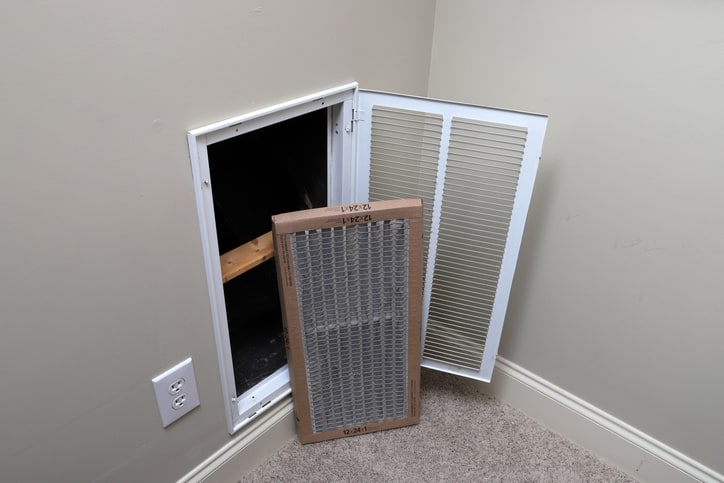
Did you know your air conditioner and heater is the most expensive appliance in your home? It requires maintenance just like your car. One of the fastest, cheapest ways you can give your air conditioner and heater a little TLC is to change your air filter.
Before you jump in your car to buy an air filter, you’ll need to gather a few pieces of information. You’ll need to determine how many filters you need and what size you need.
The easiest way to identify the size of your air filter is to take a peek at the filter that is currently in your system. The size of the filter is printed on the outside border of the filter.
If the filter does not have the dimensions printed on it, you can measure the length, width and depth (thickness) of the filter. You should have 3 numbers written in inches like this 16 x 20 x 1. Other common filter sizes include 20 x 20 x 1 and 20 x 25 x 1. Make a note of the filter size…you’ll need to remember it when you’re standing in the store and you’re faced with all the options
Where is the air filter in my HVAC system?
All central heating and cooling systems use an air filter to clean the air you breathe and protect the machine from dirt and dust. This seems like a simple question, but the answer is not so simple. There are endless places your filter could be hiding, so get ready for a scavenger hunt.
The most common places you’ll find your air filter is in the ceiling, wall or floor behind a return air grille.
For some systems, it is harder to locate the air filter, because it is stored in a slot rack beside the indoor section of your unit (furnace or air handler). The indoor section is commonly found in the attic, basement or crawlspace.
How to change your air filter
Replacing your old, dirty filter with a clean, new filter is simple. The only tool and supplies you’ll need is a screwdriver and the filter (one filter for each thermostat).
To replace the filter behind a return air grille in the ceiling, wall or floor, shut down the system by turning the thermostat to the “off” position. Open the Return Air Grille by sliding the hinge open and allowing the door to open. Carefully pull out the old, dirty filter. Insert the new filter with the arrows pointing away from you. Close the Return Air Grille door and secure the hinges to ensure the door is closed properly. Turn your system back on. Throw away the old filter.
To replace the filter stored in a slot or filter rack by your indoor unit, shut down the system by turning the thermostat to the “off” position. Open the door of the filter rack. Older systems do not have a door. You will see the filter in the open slot. Note which way the arrow on the old filter is pointing. You’ll want to install the new filter in the same direction – toward the furnace. Carefully slide the old, dirty filter out. Insert the new filter with the arrows pointing in the same direction as the old filter. The arrows should be pointed toward the furnace. Close the filter rack. Turn your system back on. Throw away the old filter.
How often should I change my filter?
How often you change your filter depends on your home environment, lifestyle and the type of filter you have. If you live in an area that is dust-free, you may only need to change your filter once every 3 months. If you have pets, smoke, or live in a dusty area you will likely need to change your filter much more often.
The frequency of changing your air filter also depends on whether you have family members with allergies or asthma. People that are sensitive to airborne particles require superior indoor air quality and nicer air filters.
A good rule of thumb is to inspect your filter once a month to see how much dust and dirt has collected. If your filter is dirty and clogged, it’s time for a new filter.
Air filters are a vital, often an under-appreciated part of the air conditioning system. Air filters serve two primary purposes: protect your HVAC system and clean the air you breathe.
The #1 reason why air conditioners and heaters fail is due to restricted air flow from a dirty filter. Over time, the dirt and dust that is not stopped by the filter will circulate through the system and accumulate on the blower wheel and coil. The restriction strains your system and overtime leads to part failure and higher repair costs.
Your system works harder when it has to breathe through a dirty filter. This added strain requires the system to use more energy to perform the job leading to higher utility bills.
If the filter is old and filled with dirt, it does not have room to attract more dirt. When there is no room on the filter, dust, dirt, and pollen are constantly circulated through your home which reduces your home’s air quality.
Replacing your filter on a regular basis will extend the life of the most valuable appliance in your home. When in doubt, change it. You cannot change your filter too often. Your lungs and wallet will thank you!







